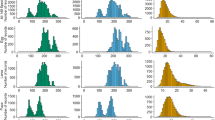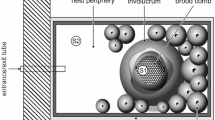Abstract
Temperature influences all biochemical and biophysiological processes within an organism. By extension, it also affects those ecological interactions that are mediated by gland-produced chemical compounds, such as reservoir-based chemical defense. Herein, we investigate how environmental temperature affects the regeneration of defensive secretions and influences the efficacy of chemical defense in a model predator-prey system: the oribatid mite Archegozetes longisetosus and the predaceous rove beetle Stenus juno. Through a combination of chemical analyses, non-linear regression modeling and theoretical simulations we show that the amount of defensive secretion responded to temperature in a unimodal optimum curve: the regeneration rate followed a positive, linear relationship up to 35 °C, but rapidly broke down beyond this temperature (“tipping point” effect). Using functional response simulations, there is an initially positive dampening effect on the predation rate when regeneration is optimal, but at higher temperatures chemical defense does not counteract the previously described effects of elevated predatory pressure. In a larger context, our results demonstrate the need to integrate relevant environmental factors in predator-prey modeling approaches.




Similar content being viewed by others
References
Aoki J (1965) Oribatiden (Acarina) Thailands I. Nat Life Southeast Asia 4:129–193
Bartoń K (2018) MuMIn: Multi-Model Inference (Version 1.42. 1)
Běhrádek J (1930) Temperature coefficients in biology. Biol Rev 5:30–58
Binzer A, Guill C, Brose U, Rall BC (2012) The dynamics of food chains under climate change and nutrient enrichment. Philos Trans R Soc Lond Ser B Biol Sci 367:2935–2944
Bolnick DI, Svanbäck R, Fordyce JA, Yang LH, Davis JM, Hulsey CD, Forister ML (2002) The ecology of individuals: incidence and implications of individual specialization. Am Nat 161:1–28
Brückner A, Heethoff M (2017a) A chemo-ecologists’ practical guide to compositional data analysis. Chemoecology 27:33–46
Brückner A, Heethoff M (2017b) The ontogeny of oil gland chemistry in the oribatid mite Archegozetes longisetosus Aoki (Oribatida, Trhypochthoniidae). Int J Acarol 43:337–342
Brückner A, Heethoff M (2018) Nutritional effects on chemical defense alter predator–prey dynamics. Chemoecology 28:1–9
Brückner A, Parker J (2020) Molecular evolution of gland cell types and chemical interactions in animals. J Exp Biol 223:jeb211938
Clarke K, Gorley R (2015) Getting started with PRIMER v7 PRIMER-E: Plymouth, Plymouth Marine Laboratory:20
Cornish-Bowden A (2012) Fundamentals of enzyme kinetics vol 510. Wiley-Blackwell, Weinheim
Deutsch CA, Tewksbury JJ, Huey RB, Sheldon KS, Ghalambor CK, Haak DC, Martin PR (2008) Impacts of climate warming on terrestrial ectotherms across latitude. PNAS 105:6668–6672
Englund G, Öhlund G, Hein CL, Diehl S (2011) Temperature dependence of the functional response. Ecol Lett 14:914–921
Florez LV, Biedermann PHW, Engl T, Kaltenpoth M (2015) Defensive symbioses of animals with prokaryotic and eukaryotic microorganisms. Nat Prod Rep 32:904–936
Hartig F (2017) DHARMa: residual diagnostics for hierarchical (multi-level/mixed) regression models R package version 0.15
Hedrick MS, Hillman SS (2016) What drove the evolution of endothermy? J Exp Biol 219:300–301
Heethoff M (2012) Regeneration of complex oil-gland secretions and its importance for chemical defense in an oribatid mite. J Chem Ecol 38:1116–1123
Heethoff M, Bergmann P, Laumann M, Norton RA (2013) The 20th anniversary of a model mite: a review of current knowledge about Archegozetes longisetosus (Acari, Oribatida). Acarologia 53:353–368
Heethoff M, Koerner L, Norton RA, Raspotnig G (2011) Tasty but protected-first evidence of chemical defense in oribatid mites. J Chem Ecol 37:1037–1043
Heethoff M, Rall BC (2015) Reducible defence: chemical protection alters the dynamics of predator–prey interactions. Chemoecology 25:53–61
Heethoff M, Raspotnig G (2012a) Investigating chemical communication in oribatid and astigmatid mites in bioassays - pitfalls and suggestions. Soil Org 84:409–421
Heethoff M, Raspotnig G (2012b) Triggering chemical defense in an oribatid mite using artificial stimuli. Exp Appl Acarol 56(4):287–295
Hoekman D (2010) Turning up the heat: temperature influences the relative importance of top-down and bottom-up effects. Ecology 91:2819–2825
Holling CS (1959) Some characteristics of simple types of predation and parasitism. Can Entomolo 91:385–398
Jones CG, Hess TA, Whitman DW, Silk PJ, Blum MS (1986) Idiosyncratic variation in chemical defenses among individual generalist grasshoppers. J Chem Ecol 12:749–761
Kingsolver JG, Higgins JK, Augustine KE (2015) Fluctuating temperatures and ectotherm growth: distinguishing non-linear and time-dependent effects. J Exp Biol 218:2218–2225
Lang B, Rall BC, Brose U (2012) Warming effects on consumption and intraspecific interference competition depend on predator metabolism. J Anim Ecol 81:516–523
Li J, Lehmann S, Weißbecker B, Naharros IO, Schütz S, Joop G, Wimmer EA (2013) Odoriferous defensive stink gland transcriptome to identify novel genes necessary for quinone synthesis in the red flour beetle, Tribolium castaneum. PLoS Gen 9:e1003596
Lomnicki A (1988) Population ecology of individuals. Princeton University Press
Luxton M (1972) Studies on oribatid mites of a Danish beech wood soil .I. Nutritional biology. Pedobiologia 12:434–463
Luxton M (1975) Studies on the oribatid mites of a Danish beech wood soil. II. Biomass, calorimetry, and respirometry. Pedobiologia 15:161–200
McCoull C, Swain R, Barnes R (1998) Effect of temperature on the functional response and components of attack rate in Naucoris congrex Stål (Hemiptera: Naucoridae). Aust J Entomol 37:323–327
Nakagawa S, Schielzeth H (2013) A general and simple method for obtaining R2 from generalized linear mixed-effects models. Methods Ecol Evol 4:133–142
Norton RA (1994) Evolutionary aspects of oribatid mite life histories and consequences for the origin of the Astigmata. In: Houck MA (ed) Mites: ecological and evolutionary analyses of life-history patterns, Chapman & Hall edn. Chapman & Hall, New York, pp 99–135
Pinheiro J, Bates D, DebRoy S, Sarkar D, Team RC (2017) Nlme: linear and nonlinear mixed effects models. R package version 3:1–131 https://cran.r-project.org/web/packages/nlme/
Rall BC, Brose U, Hartvig M, Kalinkat G, Schwarzmuller F, Vucic-Pestic O, Petchey OL (2012) Universal temperature and body-mass scaling of feeding rates. Philos Trans R Soc Lond Ser B Biol Sci 367:2923–2934
Raspotnig G (2006) Chemical alarm and defence in the oribatid mite Collohmannia gigantea (Acari: Oribatida). Exp Appl Acarol 39:177–194
Rosenzweig ML, Mac Arthur RH (1963) Graphical representation and stability conditions of predator-prey interactions. Am Nat 97:209–223
Sakata T, Norton RA (2003) Opisthonotal gland chemistry of a middle-derivative oribatid mite, Archegozetes longisetosus (Acari: Trhypochthoniidae). Int J Acarol 29:345–350
Schmidt-Nielsen K (1997) Animal physiology: adaptation and environment. Cambridge University Press, Cambridge, UK
Schulte PM (2015) The effects of temperature on aerobic metabolism: towards a mechanistic understanding of the responses of ectotherms to a changing environment. J Exp Biol 218:1856–1866
Sentis A, Hemptinne J-L, Brodeur J (2013) Parsing handling time into its components: implications for responses to a temperature gradient. Ecology 94:1675–1680
Simeone JB, Sondheimer E (1970) Chemical ecology. Academic Press, New York
Soetaert K, Petzoldt T, Setzer RW (2010) Solving differential equations in R: package deSolve. J Stat Soft 33:1–25
Symonds MR, Elgar MA (2008) The evolution of pheromone diversity. Trends Ecol Evol 23:220–228
Thiel T, Brechtel A, Brückner A, Heethoff M, Drossel B (2018) The effect of reservoir-based chemical defense on predator-prey dynamics. Theo Ecol:1–14
Wong B, Candolin U (2015) Behavioral responses to changing environments. Behav Ecol 26:665–673
Acknowledgments
We want to thank Roy A. Norton for language editing and proofreading. AB was funded by the German Nation Academic Foundation and is a Simons Fellow of the Life Sciences Research Foundation (LSRF). The study was supported by the German Science Foundation (DFG; HE 4593/5–1).
Author information
Authors and Affiliations
Contributions
AB initial idea; AB, MH designed research; CM performed experiments and chemical analysis; CM, AB modeled and statistically analyzed the data; AB wrote the first draft with input from CM; AB revised the manuscript; MH, CM commented on the manuscript.
Corresponding author
Rights and permissions
About this article
Cite this article
Merkel, C., Heethoff, M. & Brückner, A. Temperature Affects Chemical Defense in a Mite-Beetle Predator-Prey System. J Chem Ecol 46, 947–955 (2020). https://doi.org/10.1007/s10886-020-01212-3
Received:
Revised:
Accepted:
Published:
Issue Date:
DOI: https://doi.org/10.1007/s10886-020-01212-3




